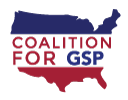Based on an analysis of new U.S. Census Bureau data, American companies paid at $113 million in tariffs on product claiming GSP in March due to GSP expiration – the highest level ever despite the fact that March is generally not a big import month. The $300 million in tariffs paid in Q1 2022 due to GSP expiration are a whopping 37% increase over Q1 2021.
Between GSP expiration on December 31, 2020 and the end of March, companies paid at least $1.35 billion in extra taxes. Those figures are the absolute minimum: well over $200 million in tariffs have been paid on products that didn’t claim GSP but may be eligible for post-renewal refunds.
Imports into 40 states (plus Puerto Rico) paid at least $1 million in tariffs due to GSP expiration. The map below shows estimated tariffs paid for products claiming GSP by state.

Surging tariff costs show not only the need for GSP reauthorization but also changes to outdated product rules such as “competitive need limitations” (CNLs). Imports from GSP countries have increased by 36% in 2022, but it would take CNL thresholds until 2035 to grow by a similar amount! The current CNL growth rate ($5 million per year) threatens to eliminate duty-free treatment for a wide range of products in the immediate future. That is on top of approximately $10 billion in trade that was already excluded from claiming GSP in 2021 due to past CNL-related decisions.
Yesterday, nearly 270 American companies and associations sent a letter to Congressional leaders outlining priorities for GSP renewal as part of conference negotiations on a compromise measure to align the U.S. Innovation and Competition Act and the America COMPETES Act (also know as the Bipartisan Innovation Act). Updating CNL rules, as has been proposed by Representatives Stephanie Murphy (D-FL) and Jackie Walorski (R-IN), were among the changes endorsed in the letter.
